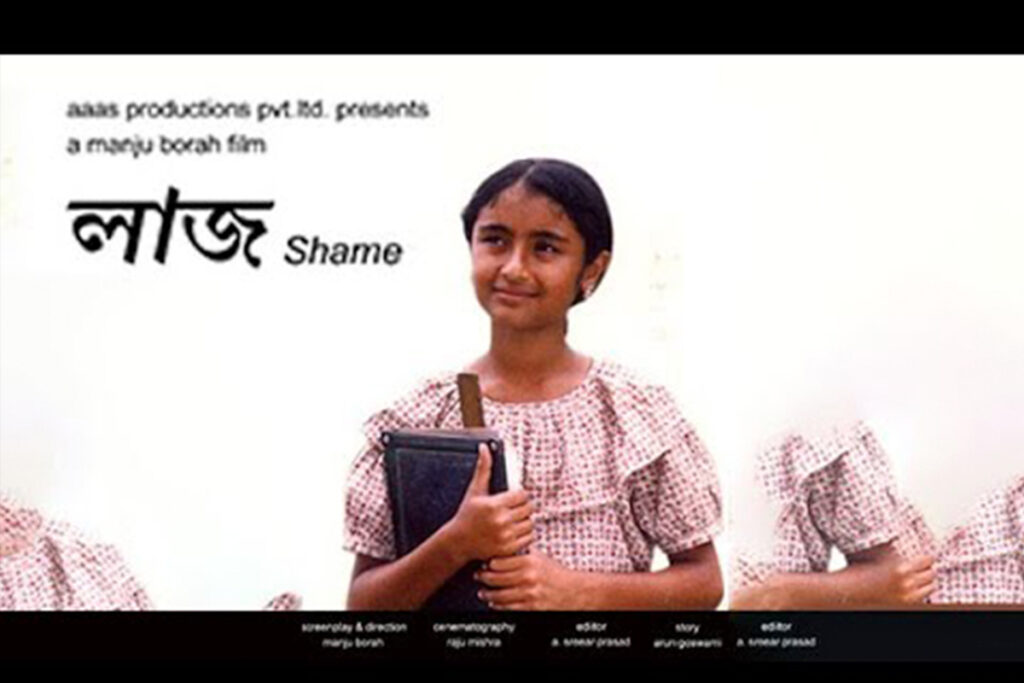Laaj (Shame)
Laaj is a 2004 Assamese film directed by Manju Borah and is an adaptation of a story written by Arun Goswami inspired by a real-life incident. The movie has received wide acclaim for its story based on a girl and direction and was even selected for screening at the London film festival in 2013.
Set up in rural Assam, the film tells the story of a young girl named Ila who is a bright student full of hopes and dreams. The film starts showing her good performance in school which earns her praise from everyone. As the film continues it presents her parents who are landless fishermen struggling to make every day ends. Her father is a chronic asthma patient who can’t afford treatment as they barely manage anything to eat. Already having four children, her mother gets pregnant with another child which has a huge impact on her health as she suffers from anemia. Ila who aimed to study hard to get a scholarship in the district starts missing her classes as her family’s suffering continues due to poverty and the ill health of her parents. With time due to a lack of prenatal care, her mother succumbs to death which leaves Ila being the eldest daughter taking up the role of a mother figure in the family household. Soon even her father becomes so frail with the illness that Ila has to take the role of earning a livelihood for her family as well as taking care of her ill father and younger siblings. With that, she is forced to give up her education even though her teachers try hard to support her and get her back to school. The ending scene of the film presents the distressing reality of her as she meets her teachers crying and tells them that she does not have underwear when being asked why she is not coming to school.
The film depicts the harsh socio-cultural reality underlined with multiple themes. With simplicity, the film traces several issues ranging from poverty, the misery of landless people, inaccessible health care, superstition, and casteism. The film portrays the cycle of structural violence which is so deep-rooted that the marginalized eventually becomes prey to it. The life of
a bold, outspoken, intelligent girl full of hopes and dreams takes a sharp turn as the reality of her condition strikes hard. She had the aim of getting a scholarship for higher education, leaving the village, getting married, and living a better life but with no money, food, and ill parents the opportunity to do better is gone. Her teachers continuously try to get her back to school telling her education will help her in the future but her presence was so deeply embedded in the vicious cycle of poverty that her future seems no different from her parents. The fact that her family was not able to access even basic amenities such as rice, soap, and paper represents the severity of poverty in rural areas where landless people look for income by doing meager jobs but still don’t earn enough to feed the family. The high debt Ila’s family has at a ration shop is one example of it.
Another issue raised in the film is the unavailability of health care which is directly linked to poverty too. Since Ila’s family barely had enough to survive they couldn’t get access to any kind of treatment. Her mother dies because of anemia and lack of prenatal care while her father becomes so frail due to asthma.in absence of treatment the poor turn towards the priest and believe in superstition for cure as shown in the film when Ila’s mother asks her to get healing water from the priest. Also, it is important to notice that women suffer more as they have to work twice harder than their male counterparts both looking after the household, and kids and then helping to earn a living. This takes a huge toll on women along with improper health care. Another point to notice in the film is the issue of caste. This can be seen When Ila goes to the
priest to take healing water and she takes shelter in the temple due to rain sitting on a mat where the priest was napping. He shouts at her calling her low caste and impure.
The main feature of the story is that it deals with the disparity between the two worlds, one which Ila dreams and aspires to and the one which is her stark reality. The scene where she dreams of getting married to a king and going to her husband’s house in a palanquin contrasts with the next scene when her mother dies and she is taken on a bier. This illustrates the gap between her dreams and reality. The clash of her dreams with reality resulted in frustration, unhappiness, and loss of her hopes and aspirations which eventually forced her to grow before time. Losing her childhood, she became a mother figure for her siblings, a homemaker, and a breadwinner for the family. The last scene of the film when she tearfully tells her teachers that she does not have underwear brutally shatters the illusion of life raising questions about that is it a shame for the girl that she can’t afford such basic essentials or for the society in which many live in such helpless conditions. The film is the microcosm of millions of poor living in Indian villages embedded in the cycle of structural poverty with women being disproportionately affected by social and economic issues which exacerbate their suffering.
Maibam Warish is a Post-Gratute scholar pursuing his Master’s in International Relations specialization in West Asian Studies, Jamia Millia Islamia, New Delhi. His field of interest includes geopolitical conflicts, India’s West Asia Relations, Energy security, Internal Security, changing power dynamics in the West Asian region, Israel’s politics, and the issues related to democratization in the region.




